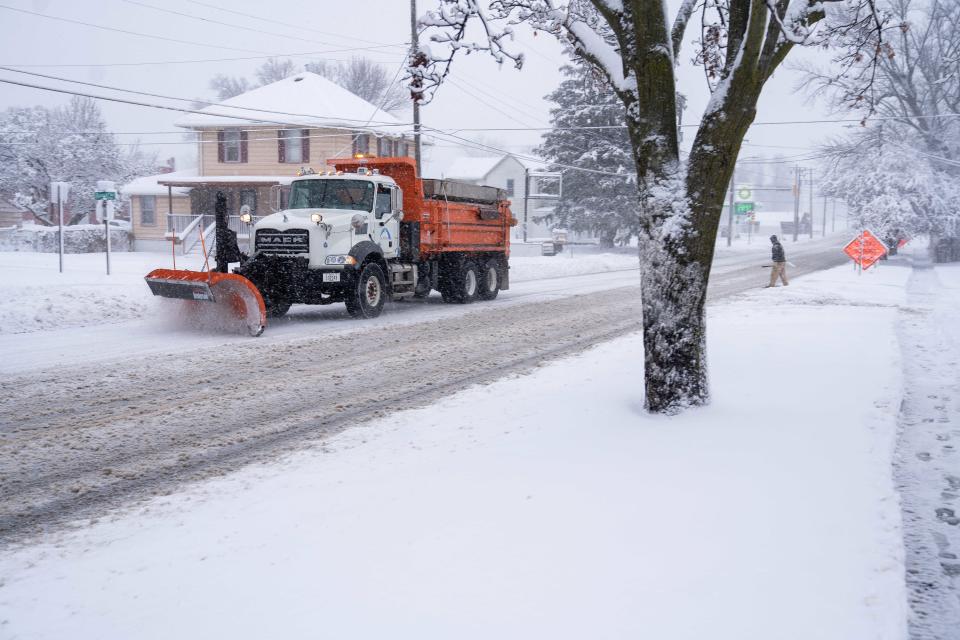In the movie, the view outside the spacecraft distorts, white stars stretching toward you and obscuring the dark space as the craft travels.
At least, that’s how Rustal Martin described it. He’s the garage operations assistant with the Iowa Department of Transportation’s Grinnell, Malcom and Tama maintenance garages.
“You feel like it’s hitting you in the forehead,” he said. “You’re out there and you’re like, ‘Man, I hope I’m where I need to be.’”
Snowplow drivers are usually “pretty close” to where they need to be, Martin said, but it’s still difficult. After all, the roadways are completely covered in snow, so you can’t see the painted road markings.
These are the challenges snowplow drivers face, but Martin and Iowa State University researchers have been working on one solution to aid drivers in the form of lane assistance technology, which would show drivers where they are on the road and alert them if they begin to drift on the roadways.
“This could just be a total game changer where you know exactly where you are in that lane,” Martin said.
What is lane assistance technology for a snowplow?

This technology will warn snowplow drivers via a display if they drift a little too far to the right or left of a roadway, Martin explained. Drivers will also be able to see an image of their vehicle and its location on the roadway.
Think of the vehicles that show drivers a bird’s eye view of their car and surrounding area on a display as they park, or the side view mirrors that will light up to indicate a car is in your blind zone to avoid potential collisions. The concept and purpose are similar to what is being developed for snowplows.
But a snowplow won’t use a camera like some cars. Blowing snow would only obscure the view, so instead, vehicles will rely on a highly accurate map of the roadway and GPS technology to track their location, said Anuj Sharma, an Iowa State University professor and co-leader of the Real-Time Analytics of Transportation Data, or Reactor, Lab.


“Lives can be saved in two ways,” he said. “One is we can keep the road clean and then the other vehicles don’t get into any crashes. But also, the drivers who are driving these snowplows, you can just think about their level of stress they are under when they’re driving in whiteout conditions, they don’t even see the lane marking.”
Sharma added that there might be times when snowplow drivers are disoriented and can cross lanes, traveling in the wrong direction of traffic.
How did research on lane assistance for snowplows start in Iowa?


Conversations about using this kind of technology go far back, Martin recalled, who has been part of research committees for the Iowa DOT for years.
If farmers were utilizing GPS for tractors, why not in snow vehicles to aid drivers in zero visibility conditions, Martin said of colleagues’ questions years ago.
He was later tasked with writing a research proposal and was awarded grant money to pursue what is now the lane guidance technology with Sharma and his team at Iowa State.
Is Iowa the first state to explore this technology for snowplows?
A different form of lane guidance has been used in at least several snowplows in Alaska as of 2019, according to trade media service Heavy Duty Trucking.
Sharma said they have been approached by drivers of emergency vehicles who are interested in this technology since they also drive in severe weather and low visibility conditions.
Where is lane guidance technology for snowplows being tested in Iowa?


The technology for lane departure and showing drivers where they are in a lane has been “fully developed” and is being tested, Sharma said.
Currently, the team has two tests taking place, but only one uses a snowplow. This technology has been installed in one Iowa DOT snowplow truck in Tama and in an SUV at Iowa State in Ames, Martin and Sharma said.
Another part of this project to detect objects and avoid collisions on roadways is still being developed and tested on just the Ames vehicle.
When will more Iowa snowplows get lane guidance technology?


The when is tied to funding.
Since showing snowplow drivers their location on a roadway requires generating a map of the area, statewide usage of this tech means the need to generate statewide maps.
Map generation for all the freeways and roads maintained by the Iowa DOT would require a one-time investment of $500,000 to $600,000, Sharma estimated. The team is also exploring options to combine already available data from snowplow vehicles and from the Iowa DOT to generate the high-resolution maps needed.
Then there is the cost to install the hardware of the technology in a snowplow, a cost Sharma is hoping to keep below $15,000 per vehicle.
The team is seeking different funding sources to deploy this in additional vehicles in the next few years.
Paris Barraza is a trending and general assignment reporter at the Des Moines Register. Reach her at pbarraza@registermedia.com. Follow her on Twitter @ParisBarraza.
This article originally appeared on Des Moines Register: Iowa DOT, Iowa State tests lane guidance to keep snowplows on the road
